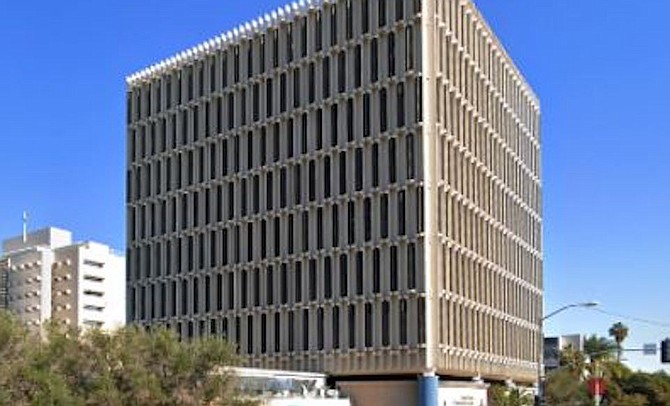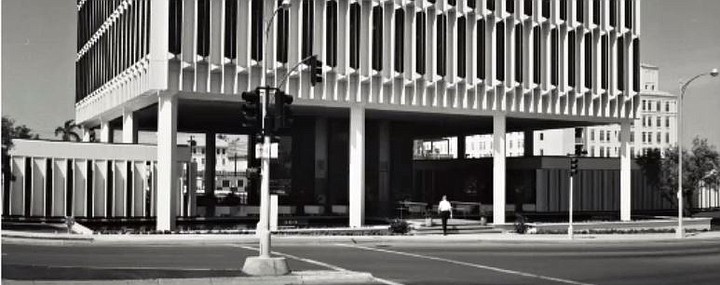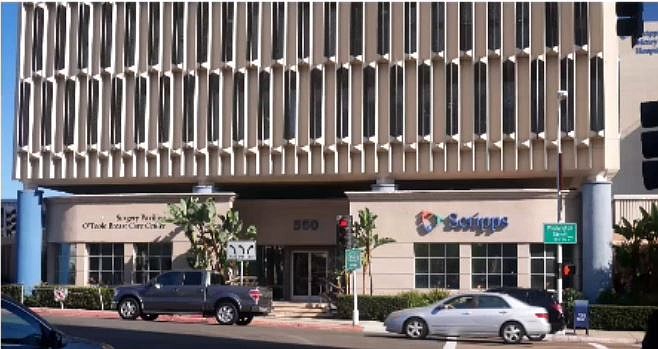 Facebook
Facebook
 X
X
 Instagram
Instagram
 TikTok
TikTok
 Youtube
Youtube

In some cities, sea rise is claiming historic buildings. In Hillcrest, a modernist tower built with San Diego's sunny climate in mind is up against modern medicine.
Its owner, Scripps Health, wants to replace it "in accordance with leading hospital standards."

The Whitson medical building, on the corner of Washington Street and Fifth Ave., can be seen from miles away in four directions, thanks to its functional passive solar design that uses sun screens to capture sunlight and shadow.
Built in 1964, the tower and its two one-story wings are a landmark, but to the hospital, it's an outdated shell.
In February, in response to a proposal to refurbish or demolish the eight-story building, the San Diego Historical Resources Board found it worthy of historic designation as a unique local example of formalism.

That rendered the building shovel-proof. But not for long.
Scripps filed an appeal, claiming factual errors, violation of bylaws or hearing procedures by the board, and new information.
Last week, the city council overturned the designation, disappointing those who consider the building an icon of the commercial corridor.
"This paves the way for the owner to demolish this well-known landmark," said Save Our Heritage Organization on its website. "The demolition "would result in the loss of one of San Diego's most important and influential post-WWII buildings."
Its aluminum “tracery” that changes with the movement of the sun throughout the day was characteristic of its designer, William S. Lewis, Jr. (Deems Martin and Associates), who liked to blend materials, function, and construction methods.
Another supporter told the council that as the pandemic recedes, holding on to history "is more important than ever before."
Scripps Mercy argues it was one of the state's hardest hit hospitals during the pandemic and to carry on "the existing hospital requires full replacement and modernization."
Part of a larger building plan announced by Scripps in 2017, the Hillcrest tower was the biggest slice of the project.
The historical designation "obstructs our ability to create a new landmark medical facility" at the site, they said.
Some buildings on Scripps campus "truly warrant historical designations" and "are an important part of our legacy," they told the city. The northern portion preserves the original chapel, nursing student housing and nursing education building. Scripps has invested in restoring these buildings for AIDS housing and health care support.
But the southern part of their campus, where the Modernist tower stands, is the focus of new development and innovation and "does not host any historic buildings."
Adjacent to the building that many begged the council to protect, Scripps is completing construction of the new Scripps Prebys/MD Anderson Cancer Center, "expanding world‐class cancer care to Hillcrest and surrounding communities."
The center "will complement the future Scripps Mercy hospital where the 550 Washington Street building is currently situated."
To continue serving San Diego into the future, "Scripps must evolve with new technologies and best medical practices in state‐of‐the‐art facilities, including on the Scripps Mercy campus."
The board granted the appeal based on factual errors - nothing could be found in the record to support a claim by Save Our Heritage that the building was nationally awarded and recognized.
They disagreed with the other claims, saying the new information that hadn't been presented to the board - which involved a 1964 San Diego magazine article and transcript from a conversation between seven local architects - was insignificant.
The board pointed out that their motion to designate under Criterion A - finding the building a unique example of San Diego's architectural development - focused on the tower and excluded the modified ground floor, which Scripps said had caused the building to lose its historic core.
The building was altered multiple times, in multiple locations.
In comments to the city, Alan Hess, an architect and architectural historian who serves as Commissioner on the California State Historical Resources Commission, said - speaking independently of the Commission - it's crucial to recognize what the alterations did not alter.
"The tower’s seven floors remain true to its original aesthetic, compared with one ground level floor which has been altered. Seven to one."


In some cities, sea rise is claiming historic buildings. In Hillcrest, a modernist tower built with San Diego's sunny climate in mind is up against modern medicine.
Its owner, Scripps Health, wants to replace it "in accordance with leading hospital standards."

The Whitson medical building, on the corner of Washington Street and Fifth Ave., can be seen from miles away in four directions, thanks to its functional passive solar design that uses sun screens to capture sunlight and shadow.
Built in 1964, the tower and its two one-story wings are a landmark, but to the hospital, it's an outdated shell.
In February, in response to a proposal to refurbish or demolish the eight-story building, the San Diego Historical Resources Board found it worthy of historic designation as a unique local example of formalism.

That rendered the building shovel-proof. But not for long.
Scripps filed an appeal, claiming factual errors, violation of bylaws or hearing procedures by the board, and new information.
Last week, the city council overturned the designation, disappointing those who consider the building an icon of the commercial corridor.
"This paves the way for the owner to demolish this well-known landmark," said Save Our Heritage Organization on its website. "The demolition "would result in the loss of one of San Diego's most important and influential post-WWII buildings."
Its aluminum “tracery” that changes with the movement of the sun throughout the day was characteristic of its designer, William S. Lewis, Jr. (Deems Martin and Associates), who liked to blend materials, function, and construction methods.
Another supporter told the council that as the pandemic recedes, holding on to history "is more important than ever before."
Scripps Mercy argues it was one of the state's hardest hit hospitals during the pandemic and to carry on "the existing hospital requires full replacement and modernization."
Part of a larger building plan announced by Scripps in 2017, the Hillcrest tower was the biggest slice of the project.
The historical designation "obstructs our ability to create a new landmark medical facility" at the site, they said.
Some buildings on Scripps campus "truly warrant historical designations" and "are an important part of our legacy," they told the city. The northern portion preserves the original chapel, nursing student housing and nursing education building. Scripps has invested in restoring these buildings for AIDS housing and health care support.
But the southern part of their campus, where the Modernist tower stands, is the focus of new development and innovation and "does not host any historic buildings."
Adjacent to the building that many begged the council to protect, Scripps is completing construction of the new Scripps Prebys/MD Anderson Cancer Center, "expanding world‐class cancer care to Hillcrest and surrounding communities."
The center "will complement the future Scripps Mercy hospital where the 550 Washington Street building is currently situated."
To continue serving San Diego into the future, "Scripps must evolve with new technologies and best medical practices in state‐of‐the‐art facilities, including on the Scripps Mercy campus."
The board granted the appeal based on factual errors - nothing could be found in the record to support a claim by Save Our Heritage that the building was nationally awarded and recognized.
They disagreed with the other claims, saying the new information that hadn't been presented to the board - which involved a 1964 San Diego magazine article and transcript from a conversation between seven local architects - was insignificant.
The board pointed out that their motion to designate under Criterion A - finding the building a unique example of San Diego's architectural development - focused on the tower and excluded the modified ground floor, which Scripps said had caused the building to lose its historic core.
The building was altered multiple times, in multiple locations.
In comments to the city, Alan Hess, an architect and architectural historian who serves as Commissioner on the California State Historical Resources Commission, said - speaking independently of the Commission - it's crucial to recognize what the alterations did not alter.
"The tower’s seven floors remain true to its original aesthetic, compared with one ground level floor which has been altered. Seven to one."
Comments